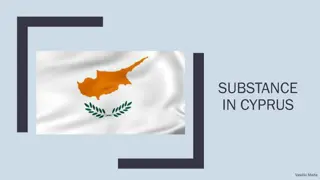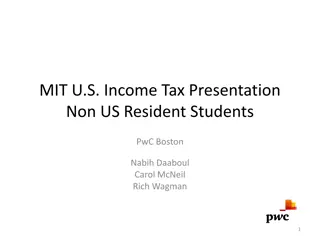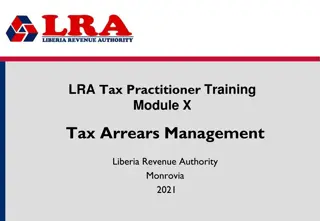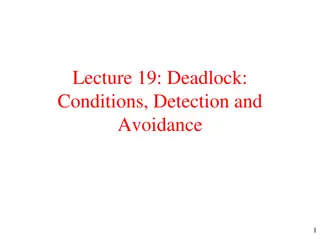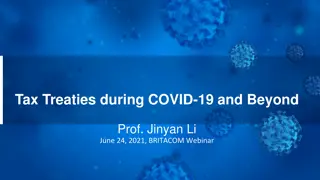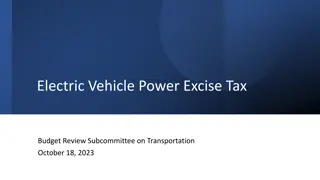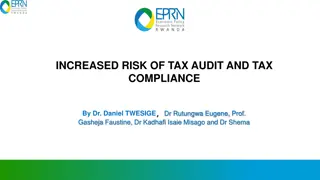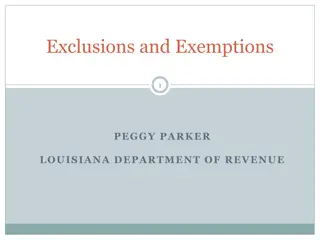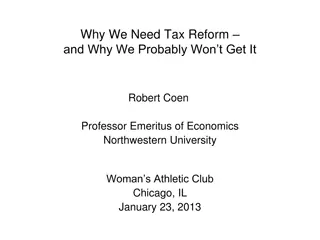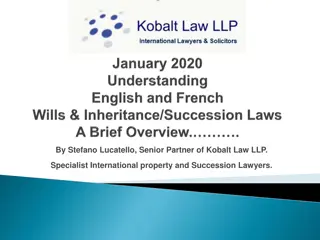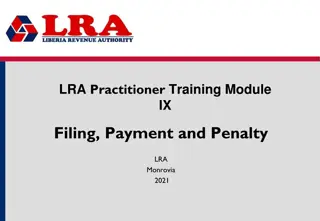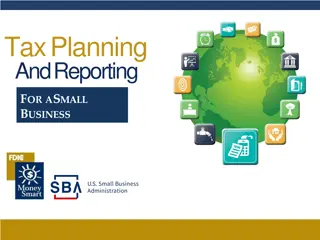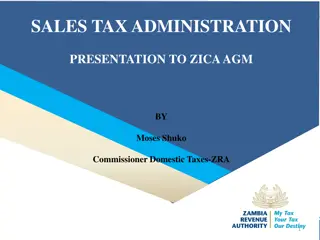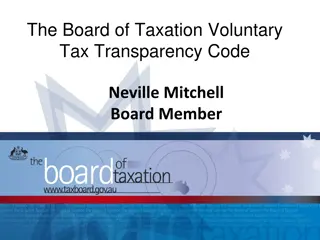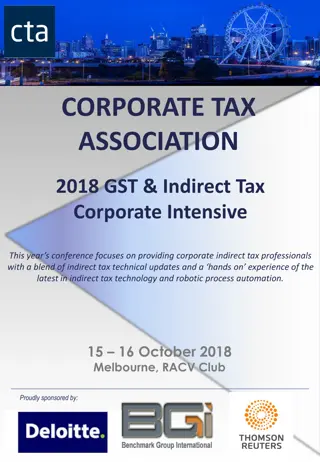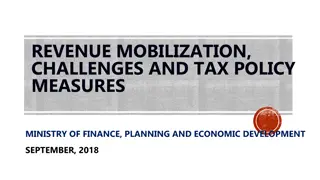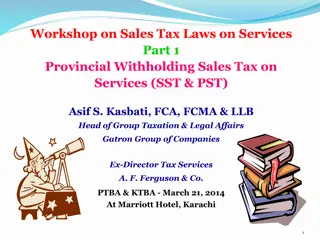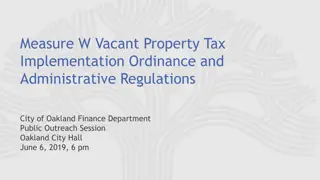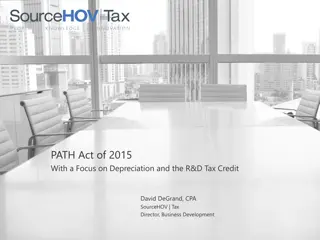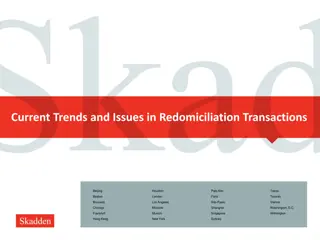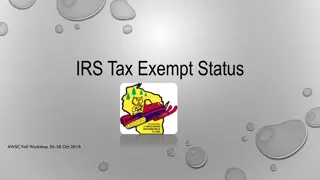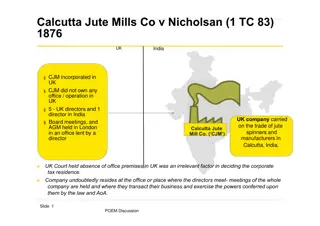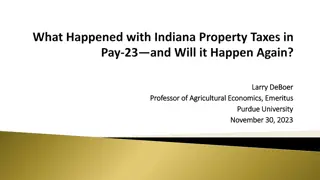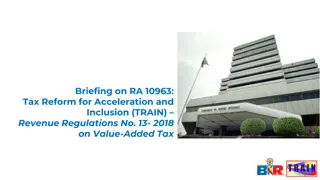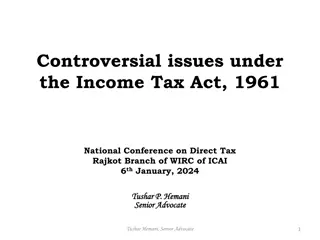Analysis of Tax Avoidance Transactions in Case Study on GAAR Application
The case study explores the incorporation of a business into a corporation to realize tax benefits, including tax deferral and lower rates. It raises questions on whether the transactions were primarily for tax avoidance purposes, highlighting the complexities of tax planning and the application of General Anti-Avoidance Rules (GAARs).
Download Presentation

Please find below an Image/Link to download the presentation.
The content on the website is provided AS IS for your information and personal use only. It may not be sold, licensed, or shared on other websites without obtaining consent from the author. Download presentation by click this link. If you encounter any issues during the download, it is possible that the publisher has removed the file from their server.
E N D
Presentation Transcript
Case studies on the application of GAARs 11 June 2019, Sessions 3-4 Capacity Building Unit Financing for Sustainable Development Office Department of Economic and Social Affairs 1 http://www.un.org/esa/ffd/
Case study 1 X, a resident of Country X, started a small business of roasting coffee beans and selling them to local independent coffee shops. The business has been quite successful and now has several employees, significant assets, and annual sales of 1 million. X has been advised by his accountant that he should establish a corporation under the laws of Country X and transfer the business to the corporation to obtain limited liability and certain tax advantages (small corporations are subject to a lower rate of tax than the top marginal rate applicable to individuals). 2
Case study 1 Consequently, X establishes a corporation and transfers all the assets and liabilities of his sole proprietorship to the company in exchange for all the shares of the company. Under the domestic law of Country X, transfers of the assets and liabilities of a sole proprietorship to a corporation in exchange for shares qualify for a tax-deferred rollover, with the result that no tax is imposed on any accrued gain at the time of the transfer to the corporation; instead, the tax is deferred until the assets are sold by the corporation or the shares in the corporation are sold. 3
Case study 1 Issue 1: Is there a transaction or series of transactions that results in a tax benefit? Incorporation of company and transfer of business constitute a series of transactions Incorporation of company by itself doesn t result in a tax benefit Transfer of business results in a tax benefit either alone or as part of series 4
Case study 1 Issue 2: What is the tax benefit? Deferral of tax on the transfer of the assets of the business is a tax benefit But not if there are losses Lower rate of tax on the company is a tax benefit resulting from the series of transactions 5
Case study 1 Issue 3: Is the main purpose or one of the main purposes of either the transfer or the series to obtain a tax benefit? Seems clear on the facts that the tax benefits were the main reason for the transactions Limited liability is an ancillary reason Therefore, transactions are tax avoidance transactions 6
Case study 1 Issue 4: Are the transfer and the series contrary to the object and purpose of the tax law? Tax law provides lower rate for small business companies and a tax-deferred rollover for transfers of a sole proprietorship to a company Transfer to a company is the normal way in which businesses grow Therefore, transactions are not contrary to the object and purpose of the tax law 7
Case study 2 ACo owns all the shares of BCo, which has accumulated losses of 1 million and has ceased to carry on business. ACo carries on a cyclical business and does not anticipate generating profits for several years. Under the domestic tax law of Country A, in which ACo and BCo are resident, losses incurred by a company are deductible against its profits and can be carried forward for 5 years. Losses of a subsidiary can be deducted by its parent after the liquidation of the subsidiary or after a merger of the parent and subsidiary. 8
Case study 2 However, a company cannot deduct losses after control of the company has changed, except to the extent of profits from the same business that gave rise to the losses. For this purpose, control means direct or indirect control. Although Country A s domestic tax law allows BCo to be liquidated or merged with ACo and allows BCo s losses to offset the profits of ACo after the liquidation or merger, ACo has no profits to absorb BCo s losses. 9
Case study 2 ACo carries out the following transactions: 1. ACo acquires preferred shares of XCo, a profitable company engaged in a business that is unrelated to the business carried on by ACo and BCo. XCo is controlled by Mr. X, who is a long-time friend of Mr. A, who controls ACo. The preferred shares are redeemable and retractable for 1,000 and carry voting rights that allow the holder to elect a majority of the board of Xco. 10
Case study 2 2. Mr. X and Mr. A enter into a shareholders agreement under which they agree that all decisions of the board of directors of XCo require the agreement of Mr. X and Mr. A. 3. Mr. A agrees to indemnify XCo and Mr. X for all costs they incur in connection with the transactions if the transactions are not successful in reducing XCo s tax. 11
Case study 2 4. XCo acquires the shares of BCo for 50,000 (5 percent of the amount of BCo s losses). 5. BCo is liquidated into XCo. 6. XCo deducts the losses of BCo against XCo s profits. 7. Once the losses of BCo have been completely used up to offset XCo s profits, the preferred shares held by ACo are redeemed for 1,000. 12
Case study 2 Issue 1: Do the transactions constitute a series? Transactions are clearly related or connected Issue 2: Does the series result in a tax benefit? Losses of BCo reduce profits of XCo Issue 3: Is the main purpose of the series to obtain a tax benefit? The only purpose of the series is to get the tax benefit since BCo has ceased to carry on business 13
Case study 2 Factors considered: only changes in financial positions of ACo and XCo are payment of 50,000 for shares of BCo economic substance is that XCo has acquired the losses of BCo for a fee of 5% of the losses series avoids the application of the change of control restrictions on the deduction of losses acquisition of voting preferred shares for nominal amount is not an arm s length transaction 14
Case study 2 Other facts redemption of preferred shares as soon as losses used up, tax indemnity, shareholders agreement preventing Mr. A from exercising control support conclusion that series is an avoidance transaction 15
Case study 2 Issue 4: Is the series contrary to the object and purpose of the tax law? Purpose is to prevent use of losses on change of control except to the extent of the profits from the business that gave rise to the losses If highly artificial series can be used to avoid loss restriction, restriction is meaningless Factors support this conclusion 16
Case study 3 ACo owns 8 percent of the shares of BCo. Under the tax law of Country A, in which ACo and BCo are resident, dividends received by one resident corporation from another resident corporation are exempt from tax if the recipient owns 10 percent or more of the value and voting rights of all the shares of the payer corporation. Other dividends received by resident corporations are subject to tax at a rate of 15 percent. 17
Case study 3 In order to take advantage of the exemption for intercorporate dividends, ACo acquires an additional 2 percent of the voting common shares of BCo in an arm s length transaction for the fair market value of the shares. This acquisition gives ACo 10 percent of the votes and value of the shares of BCo. 18
Case study 3 Acquisition of shares is clearly a transaction that results in a tax benefit One of the main purposes is to get the benefit of the exemption for dividends But is it the main purpose? Arguably the main purpose is to acquire the shares with the risks and rewards of ownership What if 10% of shares acquired in one transaction? 19
Case study 3 Even if the acquisition of the shares is a tax avoidance transaction, can aco establish that the acquisition is not contrary to the purpose of the tax law? Nothing in the law to indicate that the exemption for dividends should be denied if 10% is acquired in stages over time Economic substance of acquisition is the same as its legal form 20
Case study 3 If 2% of shares is transferred back to the original owner after the dividend is received, transaction would be contrary to the purpose of the exemption Exemption is not intended for temporary ownership, otherwise the 10% ownership condition would be rendered meaningless 21
Case study 4 ACo carries on extensive business operations in Country A. ACo requires financing in the amount of 100 million Country A currency for which the annual interest rate is 5%. Instead, ACo borrows 150 million of Country X dollars, a weaker currency, at an annual interest rate of 8% for 5 years. 22
Case study 4 ACo enters into a forward foreign exchange contract (a swap arrangement) with a bank, under which the bank provides ACo with 100 million of Country A currency in exchange for 150 million of Country X currency; ACo agrees to provide the bank with sufficient Country A currency on each interest payment date so that the bank can acquire Country X currency to pay the interest; and ACo agrees to provide the bank with sufficient Country A currency on the maturity of the loan in 5 years for the bank to repay the loan in Country X dollars. 23
Case study 4 Because future forward exchange rates between two currencies are a function of current interest rates for the two currencies, on the maturity of the loan, ACo is required to provide the bank with 85 million of Country A currency in order for the bank to repay the loan with 150 million of Country X dollars. The amount necessary to repay the loan is fixed at the time that the arrangement between ACo and the bank is entered into. 24
Case study 4 Under Country A law, interest is deductible if the borrowed funds are used to earn income. Since ACo uses the borrowed money in its business, it satisfies the conditions for the deduction of the interest For financial accounting purposes, the gain on maturity is amortized over the term of the loan and netted against the 8% rate, resulting in deductible interest of 5% annually Does the GAAR apply to the transaction? 25
Case study 4 The series of transactions results in a tax benefit in the form of higher interest deductions and possibly a capital gain on maturity One of the main purposes is clearly to obtain the tax benefit However, is the main purpose to obtain a tax benefit? Arguably the main purpose of the series is to obtain financing for ACo s business 26
Case study 4 Can the currency of the loan be treated as a separate transaction? Borrowing in Country X dollars has no commercial purpose But the currency is just one of the terms of the loan; the loan has a valid business purpose Listed factors may support argument that the main purpose is to obtain tax benefits Commercial enterprises do not borrow a currency they don t want at an interest rate higher than the rate for the currency they do want 27
Case study 4 Economic substance of the series is a synthetic borrowing of Country A currency, as shown by the financial accounting treatment In substance, the gain on maturity represents a portion of the principal amount of the loan If weak currency borrowings are allowed, why would any large company borrow in any other way? And weakest currencies would be used 28
Case study 4 Is the series contrary to the purpose of the tax law? Country A s law allows the deduction of interest, not principal; in effect, the series converts principal into interest Unlikely that the legislature would have intended this result Series is highly artificial and non-commercial 29
Case study 5 ACo, resident in Country A, owns all the shares of BCo, resident in Country B. BCo has recently ceased to carry on business and sold all its business assets; as a result, BCo s assets consist exclusively of cash and near-cash. ACo sells the shares of BCo to XCo, another company resident in Country B that is unrelated to ACo, for their fair market value, less a small discount. 30
Case study 5 The fair market value of the shares of BCo is equal to the value of BCo s cash and near-cash assets. The purchase price of the shares is satisfied by XCo issuing a note to ACo for the entire amount. After the sale, XCo causes BCo to be liquidated and all its assets are distributed to XCo. XCo then uses the funds to repay its note payable to ACo. 31
Case study 5 Under Country B s law, withholding tax of 20% is imposed on dividends paid by resident corporations to non-residents. Further, on the liquidation of a resident corporation (and on a redemption of its shares and other similar transactions), the corporation is deemed to have paid a dividend to its shareholders equal to the fair market value of its assets in excess of the stated capital of its shares. (Assume that the stated capital of the shares of BCo is a nominal amount.) 32
Case study 5 Country B imposes tax on capital gains realized by residents and non-residents with respect to the disposition of shares of corporations resident in Country B, but the tax is imposed at a preferential rate of 10% of the gain. 33
Case study 5 Country A and Country B have concluded a tax treaty with provisions identical to those of the United Nations Model Convention, except that the treaty does not contain Article 13(5) or a general anti-abuse rule like Article 29(9). Under Article 10 of the treaty, the withholding tax on dividends is reduced to 10 percent for dividends paid by a corporation resident in Country B to a corporation resident in Country A that owns 25 percent or more of the shares of the payer corporation. 34
Case study 5 Series of transactions results in a tax benefit If BCo had been liquidated, ACo would have been deemed to receive a dividend equal to the value of BCo s assets and would have been liable for withholding tax at 20%, reduced to 10% under the treaty Instead, ACo makes a capital gain, which is exempt from Country B tax under Article 13 of the treaty 35
Case study 5 Definition of tax benefit includes a benefit under a tax treaty; therefore, the reduced rate of withholding on the dividend and the exemption of the capital gain are both tax benefits Ignoring the treaty, there is still a tax benefit since Country B s tax on the capital gain is less than the withholding tax on dividends 36
Case study 5 One of the main purposes and the main purpose of the series was to obtain the tax benefit Factors support this conclusion: Commercial purpose could have been accomplished more directly by BCo paying a dividend or liquidating, but would have resulted in withholding tax No change in financial positions 37
Case study 5 XCo is just an accommodation party; it has no interest in the series other than its fee Economic substance is that the assets of Bco have been distributed to ACo Therefore, series is a tax avoidance transaction Alternatively, sale of shares to XCo could be attacked since it has no commercial purpose; XCo is only acquiring cash to pass on to ACo 38
Case study 5 Is the series contrary to the object and purpose of Country A s law or the treaty? Purpose of Country B s law is to tax liquidating distributions as dividends and impose withholding tax on nonresident shareholders If nonresidents sell shares, capital gains treatment, but capital gains treatment should be able only for real sales 39
Case study 5 No commercial reason for ACo to sell or XCo to buy a company whose only assets are cash Not a genuine sale; artificial arrangement to avoid withholding tax Therefore, contrary to purpose of the law imposing withholding tax on dividends and law providing capital gains treatment for genuine sales of shares by nonresidents 40
Case study 5 Also contrary to the purpose of Country B s law taxing dividends and capital gains differently Country B treats corporate distributions on disposals of shares (e.g., redemptions, liquidations, etc.) as deemed dividends; therefore, purpose is to tax transactions that result in distribution of corporate surplus as dividends Distributions to nonresident shareholders subject to withholding tax 41
Case study 5 Series involves disguised sale to a tax-indifferent party to effect a distribution of BCo s assets without any withholding tax Therefore, the series is contrary to the purpose of the provisions of Country B s law dealing with deemed dividends and withholding tax; those provisions are meaningless if they can be avoided so easily 42
Case study 5 Series is also contrary to the provisions of the tax treaty between Country A and Country B Nothing in the treaty to prevent Country B from applying its GAAR (Commentary on Article 1) No conflict between domestic law and treaty Country B taxes dividend at 10% in accordance with Article 10 and does not tax any capital gain, so no conflict with Article 13 43
Case study 5 Even if treaty is interpreted to prevent the application of Country B s GAAR, treaty itself can be interpreted to disallow treaty benefits Guiding principle in para. 22 of Commentary on Article 1 allows country to disallow treaty benefits if one of the purposes of a transaction is to obtain those benefits and it would be contrary to the object and purpose of the treaty to grant those benefits 44
Case study 5 On the facts of case study 5, one of the purposes of the series was clearly to avoid withholding tax and get the benefit of the exemption for capital gains in Article 13 Purpose of the treaty is not to grant the benefits of Article 13 to disguised sales to tax-indifferent parties 45
Case study 5 Tax benefits of the series should be denied either under Country B s GAAR or under a proper interpretation of the treaty Under GAAR, tax authorities should ignore the sale to XCo and treat the sale proceeds as a dividend subject to withholding tax at 10% under the treaty Under treaty, tax authorities should deny Article 13 exemption and impose withholding tax at 10% or tax as a capital gain 46
Thank you TaxffdCapDev@un.org 47 http://www.un.org/esa/ffd/


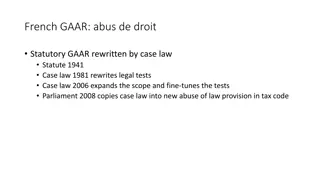

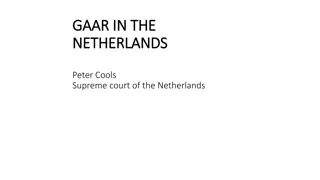

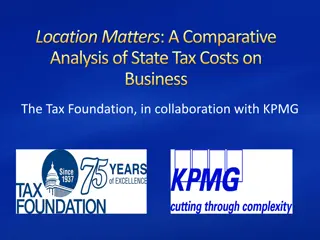




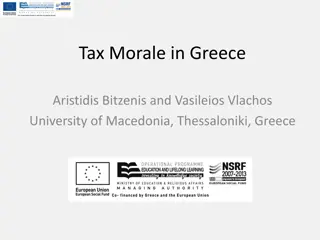
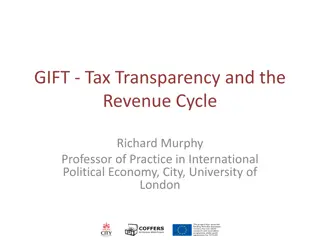
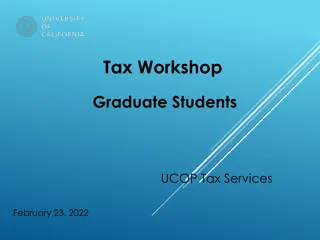

![Town of [Town Name] Real Estate Tax Rates and FY 2024 Budget Summary](/thumb/62211/town-of-town-name-real-estate-tax-rates-and-fy-2024-budget-summary.jpg)

